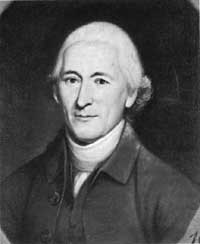







Biographical Sketches
|
LEWIS MORRIS New York |
 Lewis Morris | |
| ||
Born in 1726, Morris was the eldest son of the second lord of the vast manor of Morrisania, in Westchester (present Bronx) County, N.Y. Upon graduating from Yale College in 1746, he helped manage the estate. Three years later, he married, siring 10 children. In 1762, when his father died, he inherited Morrisania and became its third lord. About this time, he gained an interest in local politics, and in 1769 served a term in the colonial legislature.
As time went on, though residing in a pro-Loyalist county, Morris became increasingly critical of British policy. In 1775 he helped organize a meeting at White Plains that overcame strong opposition and chose county delegates, including Morris as chairman, to New York's first provincial convention. It elected him to the Continental Congress (1775-77), where he specialized in military and Indian affairs. For most of 1776, he was absent from Philadelphia, serving as a brigadier general in the Westchester County militia. During the British invasion of New York that year, the redcoats ravaged Morrisania, and forced Morris' family to flee.
When his career in Congress ended, Morris rose to the rank of major general in the militia and became a county judge (1777-78) and State senator (1777-81 and 1784-88). After war's end in 1783, when he was able to return to Morrisania, he devoted much of his time to rehabilitating it. In 1784 he sat on the first board of regents of the University of New York. And 4 years later, at the State ratifying convention in Poughkeepsie, he strongly supported Alexander Hamilton's successful drive for approval of the U.S. Constitution.
Morris died in 1798 at Morrisania at the age of 71. His grave is in the family vault in the yard of St. Ann's Church in the Bronx.
Drawing: Oil, 1873, by Charles N. Flagg, after John Trumbull, Indpendence National Historical Park.
 |
 |
http://www.cr.nps.gov/history/online_books/declaration/bio32.htm
Last Updated: 04-Jul-2004